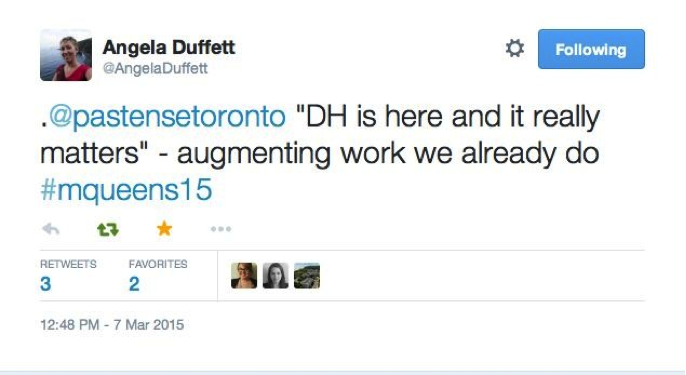On the Use of Digital Humanities in the History Classroom
7 Avril 2015 - 2:19pm
There can be little doubt about the importance of the Digital Humanities in current discussions about teaching the humanities both in school curriculum and post-secondary course design.
It seems in terms of pedagogy that the Digital Humanities are not only here to stay, but are an integral part of how we do our work both as historians and as educators. Indeed, Kevin Kee’s work on gaming and the teaching of history promises that there is much to be gained – and to be learned – by integrating digital technologies and methods into the classroom.
People are interacting with the past through digital media and the internet more and more – if you’re interested take a look to see how many historians are on twitter, it seems like we all are – and that digital technologies are an integral and often trusted way people now interact with the past. If historians are to build narratives, or evidence-based stories, about the past, then ignoring digital platforms seems almost impossible.
As we navigate the somewhat-new waters of the digital humanities, and as I reflect on my own experiences integrating digital humanities into my university teaching in history, I raise a few points to consider and share my experience developing a Digital History Project for a History class of 24 university undergraduates.
There is no one understanding of what we mean by Digital Humanities
There is no singular definition of the digital humanities; it can mean a variety of different digital processes in a variety of contexts. In some cases the digital humanities involve the use of technology to collect data; an example of this would be the use of GIS systems and data to create 3-D images from historical maps or to overlay different maps over one another to assess continuity or change over time.
Sometimes the digital humanities is used to refer to the digitization of archives; that is to say, the availability of historical photographs, artifacts, media, documents etc. in digital forms, often freely accessible through archive and library websites. This process is commonly included in understandings of the Digitization of History.

At the recent McGill-Queen’s Graduate Student Conference in History, there was a roundtable on the Digital Humanities. The conference was live-tweeted; the example above is part of my own commentary on the Digital Humanities re-tweeted by a conference participant.
Often, the digital humanities are used to refer to the integration of technology – including communications technologies such as social media – into the ways humanities research is conducted and the ways humanities courses are taught. The digital humanities in this sense use new technologies and platforms to reproduce, promote, and engage those within and outside the humanities in the kinds of research scholars are generating.
The Digital History Project
I developed a Digital History Project as part of a fourth-year university History seminar of 24 students. It was the main assessment for the course, and the different components accounted for 40% of the final grade weighting. The “Digital History Project” consisted of two parts: a written Digital History Essay, based on a traditional essay format, and the Digital History Portion which was a five minute video students crafted from information collected in their essays. The Digital History Project presented students with this challenge: if you only have five minutes to get your point across, what is the message and what is your evidence?
My goal was to help students develop new skills outside of the writing skills set they already had. I wanted to engage students in the important skill of presenting and summarizing information effectively and cohesively.
Student reactions to the project:
In informal student survey results a student reported the, “use of digital media made the course more interesting and in tune with contemporary approaches to learning, from projects to videos.”
Another reported that though the task of creating a Digital Project was difficult it was in the end rewarding and created new skills, “I liked how [there] was an alternative approach (Digital History Project). Yes at times I wanted to throw my computer against the wall, but once you work through that, I found I learned a lot and really appreciated the project.”
Many students expressed to me the anxieties they felt over this assignment. Most of them had no experience putting together a video on their computers, although every computer comes with built-in and free programs to make videos (windows movie maker and iMovie). Even powerpoint has a feature where students can record voiceovers and moving images.
A lot of my time was spent reassuring and encouraging students that they could complete the project well. Many of themselves were hesitant about expressing and sharing their work digitally because they had never done it before. And this was exactly the reason why I integrated the digital humanities into my syllabus.
Concluding Thoughts
By including students in the kind of hard decision making historians engage with in their work, students more comprehensively understood the nature of evidence and developed the ability to more critically evaluate the narratives constructed by others. Students actively engaged in the work of historians, rather than only learning about it.
In the case of history specifically, the digital humanities are an ever-present and growing presence. In a discipline based on the written word, the careful construction of narrative, and the close connection between argument and evidence many have been reluctant to embrace the digital humanities, some even suspicious of it. Yet Stéphane Lévesque argues, “…the question should no longer be about whether to use digital technology but rather how to use it to further the acquisition and development of expertise in domains of knowledge.”
- Se connecter ou créer un compte pour soumettre des commentaires

